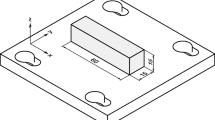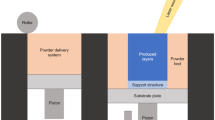Abstract
Digital Light Processing (DLP) was used to prepare porous alumina ceramics. By comparing rheological and curing properties of slurries with different solid content, alumina slurries with high solid content were proposed. The green bodies were sintered in an air atmosphere after a nitrogen-air double-step debinding, and the relative density of alumina ceramics prepared by a slurry of 72.5 wt.% solid content reached 96%. In addition, three kinds (Gyroid, Diamond, and F-RD) of triply period minimal surface (TPMS) structural models with different volume fractions were established through implicit functions and simulated in Comsol. The simulation results showed that the Gyroid structure has a higher compression property than the other two structures under the same ceramic volume fraction. The TPMS structural alumina green bodies were sintered after DLP printing. The maximum compressive strength of the Gyroid structure with 60% ceramic volume fraction reached 27.42 MPa.













Similar content being viewed by others
Data availability
Commercial software COMSOL Multiphysics®
Code availability
Not applicable.
References
Li X, Gao M, Jiang Y (2016) Microstructure and mechanical properties of porous alumina ceramic prepared by a combination of 3–D printing and sintering. Ceram Int 42(10):12531–12535. https://doi.org/10.1016/j.ceramint.2016.05.027
Chen Y, Wang N, Ola O, Xia Y, Zhu Y (2021) Porous ceramics: light in weight but heavy in energy and environment technologies. Mater Sci Eng R: Reports 143:100589. https://doi.org/10.1016/j.mser.2020.100589
Liu J, Ren Bo, Yuju Lu, Xi X, Li Y, Liu K, Yang J, Huang Y (2019) Novel design of elongated mullite reinforced highly porous alumina ceramics using carbonized rice husk as pore-forming agent. Ceram Int 45(11):13964–13970. https://doi.org/10.1016/j.ceramint.2019.04.095
He X, Zhou X, Bo Su (2009) 3D interconnective porous alumina ceramics via direct protein foaming. Mater Lett 63(11):830–832. https://doi.org/10.1016/j.matlet.2008.12.021
Wang J, Zhao J (2017) Investigating the effect of SPRM on mechanical strength and thermal conductivity of highly porous alumina ceramics. Ceram Int 43(18):16430–16435. https://doi.org/10.1016/j.ceramint.2017.09.022
Isobe T, Tomita T, Kameshima Y, Nakajima A, Okada K (2006) Preparation and properties of porous alumina ceramics with oriented cylindrical pores produced by an extrusion method. J Eur Ceram Soc 26(6):957–960. https://doi.org/10.1016/j.jeurceramsoc.2004.11.015
Vijayan S, Narasimman R, Prabhakaran K (2013) A urea crystal templating method for the preparation of porous alumina ceramics with the aligned pores. J Eur Ceram Soc 33(10):1929–1934. https://doi.org/10.1016/j.jeurceramsoc.2013.02.031
Liu RZ, Chen P, Wu JM, Chen S, Chen AN, Chen JY, Liu S-S, Shi YS, Li CH (2018) Effects of B4C addition on the microstructure and properties of porous alumina ceramics fabricated by direct selective laser sintering. Ceram Int 44(16):19678–19685. https://doi.org/10.1016/j.ceramint.2018.07.220
Zhang K, Liu T, Liao W, Zhang C, Yan Y, Daozhong Du (2016) Experiment on selective laser melting forming of alumina ceramics. Chin J Lasers 43(10):126–132. https://doi.org/10.3788/CJL201643.1002007
Mariani M, Beltrami R, Brusa P, Galassi C, Ardito R, Lecis N (2021) 3D printing of fine alumina powders by binder jetting. J Eur Ceram Soc 41(10):5307–5315. https://doi.org/10.1016/j.jeurceramsoc.2021.04.006
Mamatha S, Biswas P, Ramavath P, Das D, Johnson R (2021) Effect of parameters on 3D printing of alumina ceramics and evaluation of properties of sintered parts. J Asian Ceram Soc 9(3):858–864. https://doi.org/10.1080/21870764.2021.1920159
Haidong Wu, Cheng Y, Liu W, He R, Zhou M, Shanghua Wu, Song X, Chen Y (2016) Effect of the particle size and the debinding process on the density of alumina ceramics fabricated by 3D printing based on stereolithography. Ceram Int 42(15):17290–17294. https://doi.org/10.1016/j.ceramint.2016.08.024
Sun L, Dong P, Zeng Y, Chen J (2021) Fabrication of hollow lattice alumina ceramic with good mechanical properties by Digital Light Processing 3D printing technology. Ceram Int 47(18):26519–26527. https://doi.org/10.1016/j.ceramint.2021.06.065
Bobbert FSL, Lietaert K, Eftekhari AA, Pouran B, Ahmadi SM, Weinans H, Zadpoor AA (2017) Additively manufactured metallic porous biomaterials based on minimal surfaces: a unique combination of topological, mechanical, and mass transport properties. Acta Biomater 53:572–584. https://doi.org/10.1016/j.actbio.2017.02.024
Catchpole-Smith S, Sélo RRJ, Davis AW, Ashcroft IA, Tuck CJ, Clare A (2019) Thermal conductivity of TPMS lattice structures manufactured via laser powder bed fusion. Addit Manuf 30:100846. https://doi.org/10.1016/j.addma.2019.100846
Yao Y, Qin W, Xing B, Sha Na, Jiao T, Zhao Z (2021) High performance hydroxyapatite ceramics and a triply periodic minimum surface structure fabricated by digital light processing 3D printing. J Adv Ceram 10:39–48. https://doi.org/10.1007/s40145-020-0415-4
Gandy PJF, Cvijović D, Mackay AL, Klinowski J (1999) Exact computation of the triply periodic D (‘diamond’) minimal surface. Chem Phys Lett 314(5–6):543–551. https://doi.org/10.1016/S0009-2614(99)01000-3
Yang S-D (2010) Hyun Geun Lee, Junseok Kim, A phase-field approach for minimizing the area of triply periodic surfaces with volume constraint. Comput Phys Commun 181(6):1037–1046. https://doi.org/10.1016/j.cpc.2010.02.010
Acknowledgements
The authors would like to acknowledge the support of the Advanced Ceramics Institute of Zibo, the National Key Research and Development Plan.
Funding
This work was supported by the National Key Research and Development Plan (2021YFB3703100), the Hubei High Value Patent Cultivation Project (2021pm0012), the National Natural Science Foundation of China (U1806221, 51672198), the Innovation and Development Project of Zibo City (2017CX01A022), the Instruction & Development Project for National Funding Innovation Demonstration Zone of Shandong Province (2017-41-1, 2017-41-3, 2018ZCQZB01, 2019ZCQZB03), the Central Guiding Local Science and Technology Development Special Funds (2060503), and the Key Research & Design Program of Shandong Province (2019GGX102011).
Author information
Authors and Affiliations
Contributions
All authors contributed to the study conception and design. Z. Zhang conducted experiments with the guidance of K. Liu; The manuscript was written by Z. Zhang, K. Liu, and Y. Du. All authors evaluated the conclusions of the manuscript and approved it.
Corresponding author
Ethics declarations
Ethical approval
Not applicable.
Consent to participate
All authors consent to participate.
Consent for publication
All authors consent to publish.
Conflict of interest
The authors declare no competing interests.
Additional information
Publisher's note
Springer Nature remains neutral with regard to jurisdictional claims in published maps and institutional affiliations.
Rights and permissions
Springer Nature or its licensor (e.g. a society or other partner) holds exclusive rights to this article under a publishing agreement with the author(s) or other rightsholder(s); author self-archiving of the accepted manuscript version of this article is solely governed by the terms of such publishing agreement and applicable law.
About this article
Cite this article
Liu, K., Zhang, Z., Sun, H. et al. Fabrication and mechanical properties of triply period minimal surface porous alumina ceramics based on Digital Light Processing 3D printing technology. Int J Adv Manuf Technol (2023). https://doi.org/10.1007/s00170-023-11164-z
Received:
Accepted:
Published:
DOI: https://doi.org/10.1007/s00170-023-11164-z




